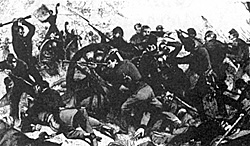
The following account is another installment in a series of eyewitness accounts which THE COURIER will carry from time to time. The accounts will stress tactical details from all periods presented by eyewitnesses. They will thus be either historically significant or important from a wargaming standpoint. In the latter case, the accounts will provide information about weapons, formations, and tactics.
ACTION AT TURNER'S GAP
On September 14, 1862, the Union 4th Brigade of Doubleday's 1st Division, Hookers Corps of the Army of the Potomac received orders to clear Turners Gap outside of Frederick, Maryland. The order was stimulated by the high command's fortuitous discovery of Lee's master plan for the invasion of Maryland. Armed with cetain information about Lee's scattered dispositions McClellan planned to defeat the Confederates in detail. However, the rival armies were separated by a low mountain range known as South Mountain. The Union 4th Brigrade, under the command of General Gibbon, was part of the spearhead sent to penetrate this barrier.
The following account of the resultant battle at Turner's Gap is taken from Major Rufas Dawes' Service with the Sixth Wisconsin Volunteers published in 1890 in Marietta, Ohio. It is provided by Daniel Beattie and vividly describes the Volunteer's advance. Note the use of the column and line formations and the mention of the fire discipline employed by the 6th Wisconsin. The gallant ability of the 6th to change formations under fire should not be unexpected (along with the 2nd and 7th Wisconsin and 19th Indiana, the 6th formed the formidable Iron Brigade). So, to the late afternoon of September 14 and the wooded slopes of South Mountain:
The sun was sinking behind the mountain, when our order came to move forward. The two regiments in front (7th Wisconsin and 19th Indiana) moved in line of battle. Our regiment and the 2nd Wisconsin followed at supportiing distance, formed in double columns. Thus we went down into the valley and began to climb the slope of the mountain. The regiment was halted in an orchard and two companies were sent forward as skirmishers.
Our skirmishers immediately encountered skirmishers of the enemy and drove them slowly up the mountain, fighting for every inch of the ground. just at dusk we came to a rough, stony field, skirted on its upper edge by timber. Our skirmishers had encountered the enemy in force and were behind a fence. The seventh Wisconsin in front of us, climbed the fence and moved steadily forward across the field and we followed them, our regiment being formed in double co/umn. Suddenly the seventh Wisconsin halted and open fire, and we could see a rapid spitting of musketry flashes from the woods above and in front of us, and wounded men from the seventh began to hobble by us. The sharpest fire came from a stone wall, running along a ravine toward the left of the seventh. Captain John B. Callis was in command of the regiment.
He ordered a change of front, throwing his right forward to face the wall; but there burst from the woods, skirting the right of the field, a flame of musketry which sent a shower of bullets into the backs of the men of the right of the seventh Wisconsin.
Many men were shot by the enfilading fire to which they could make no reply. Captain Richardson came running toward us shouting: "Come forward, Sixth!" Sharp and clear rang out on the night, the voice of Bragg: "Deploy column! By the right and left flanks, double quick, march!" The living machine responded to this impulsive force with instant action, and the column was deployed into line of battle. The right wing of our regiment came into open field, but the left wing was behind the seventh. "Major!" ordered Bragg, "take command of the right wing and fire on the woods!" I instantly ordered: "Attention, right wing, ready, right oblique, aim, fire, load at will, load!"
The roll of this wing volley had hardly ceased to reverberate, when Bragg said: "Have our men lie down on the ground, I am going over you." "Right wing, lie down! look out", the left wing behind the right wing and he ordered them forward over the men of the right wing as they laid upon the ground. The left wing fired a volley into the woods, and the right wing fired a volley into the woods, and the right wing advanced in the same manner over them and fired a volley into the woods.
Once more Bragg gave a volley by the left wing. There were four volleys by wing given, at the word command. In a long experience in musketry fighting, this was the single instance I saw of other than a fife by file in battle. Our whole line was slowly advanced up the mountain, the men shouting and firing, the rebels behind the stone wall and in the timber would shout: "0, you damn Yanks, we gave you hell again at Bull Run!"
Our men would shout back: Never mind Johnny, its no McDowell after you now. 'Little Mac' and 'Johnny Gibbon' are after you now." The rebels fell back from the woods, but stuck to the stone wall. The hostile lines had approached each other closely and the fire was deadly. Many of our men were falling, and we could not long endure it. Our cartridges were getting short and our guns were dirty with bad powder. Gradually by direction of Colonel Bragg we ceased firing and lay still on the ground.
Back to Table of Contents -- Courier Vol. III #6
To Courier List of Issues
To MagWeb Master Magazine List
© Copyright 1982 by The Courier Publishing Company.
This article appears in MagWeb (Magazine Web) on the Internet World Wide Web.
Other military history articles and gaming articles are available at http://www.magweb.com